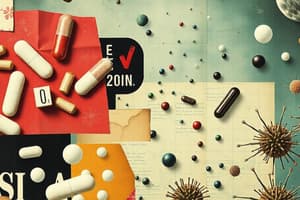Podcast
Questions and Answers
An ______ drug is used to treat a microbial infection.
An ______ drug is used to treat a microbial infection.
antimicrobial
Antibiotics are drugs that kill or inhibit the growth of ______.
Antibiotics are drugs that kill or inhibit the growth of ______.
bacteria
The zone of ______ is an area where bacteria have not grown enough to be visible due to the effects of an antibiotic.
The zone of ______ is an area where bacteria have not grown enough to be visible due to the effects of an antibiotic.
inhibition
Narrow-spectrum antibiotics affect only a select group of ______.
Narrow-spectrum antibiotics affect only a select group of ______.
Broad-spectrum antibiotics can affect a ______ number of microbes.
Broad-spectrum antibiotics can affect a ______ number of microbes.
Penicillin is an example of an antibiotic that contains a ______ ring.
Penicillin is an example of an antibiotic that contains a ______ ring.
Aminoglycosides and tetracyclines inhibit protein synthesis at ______ ribosomes.
Aminoglycosides and tetracyclines inhibit protein synthesis at ______ ribosomes.
Antibiotics can target bacterial cell wall synthesis, plasma membrane, and bacterial ______.
Antibiotics can target bacterial cell wall synthesis, plasma membrane, and bacterial ______.
Rifamycin inhibits ______ synthesis.
Rifamycin inhibits ______ synthesis.
Quinolones and fluoroquinolones inhibit ______ gyrase.
Quinolones and fluoroquinolones inhibit ______ gyrase.
Beta-lactamases hydrolyze ______ drugs.
Beta-lactamases hydrolyze ______ drugs.
Antifungal drugs are used to treat and prevent ______.
Antifungal drugs are used to treat and prevent ______.
______ Inhibitors are a group of antiretroviral drugs.
______ Inhibitors are a group of antiretroviral drugs.
Metronidazole is an antibiotic used to treat a wide variety of ______.
Metronidazole is an antibiotic used to treat a wide variety of ______.
Chloroquine stops ______ synthesis by intercalation.
Chloroquine stops ______ synthesis by intercalation.
Aminoglycoside-modifying enzymes render aminoglycosides ______.
Aminoglycoside-modifying enzymes render aminoglycosides ______.
Flashcards
Zone of Inhibition
Zone of Inhibition
An area around a disk where bacteria have not grown enough to be visible, indicating the effectiveness of an antibiotic.
Narrow-Spectrum Antibiotics
Narrow-Spectrum Antibiotics
Antibiotics that target a limited range of bacteria, typically gram-positive.
Broad-Spectrum Antibiotics
Broad-Spectrum Antibiotics
Antibiotics that are effective against a broad range of bacteria, including both gram-positive and gram-negative.
Inhibitors of Cell Wall Synthesis
Inhibitors of Cell Wall Synthesis
Signup and view all the flashcards
Inhibitors of Protein Synthesis
Inhibitors of Protein Synthesis
Signup and view all the flashcards
Inhibitors of Nucleic Acid Synthesis
Inhibitors of Nucleic Acid Synthesis
Signup and view all the flashcards
Antibiotic Activity
Antibiotic Activity
Signup and view all the flashcards
Antibiotic Resistance
Antibiotic Resistance
Signup and view all the flashcards
Quinolones and Fluoroquinolones: How do they work?
Quinolones and Fluoroquinolones: How do they work?
Signup and view all the flashcards
Acquired Resistance: How do bacteria become resistant?
Acquired Resistance: How do bacteria become resistant?
Signup and view all the flashcards
Beta-lactamases: What's their role in resistance?
Beta-lactamases: What's their role in resistance?
Signup and view all the flashcards
Aminoglycoside-modifying enzymes: What do they do?
Aminoglycoside-modifying enzymes: What do they do?
Signup and view all the flashcards
Mutation: How does bacterial resistance arise from alterations in PBPs?
Mutation: How does bacterial resistance arise from alterations in PBPs?
Signup and view all the flashcards
Efflux Pumps: Their role in antibiotic resistance?
Efflux Pumps: Their role in antibiotic resistance?
Signup and view all the flashcards
Antiretroviral Drugs: What are their targets?
Antiretroviral Drugs: What are their targets?
Signup and view all the flashcards
Antifungal Drugs: Their purpose?
Antifungal Drugs: Their purpose?
Signup and view all the flashcards
Study Notes
Antimicrobial Drugs
- Antimicrobial drugs treat microbial infections.
- Antibiotics kill or inhibit bacterial growth, used to treat bacterial infections.
Antibiotics
- Fight pathogens.
- Interfere with cell wall formation.
- Many are obtained from bacteria or fungi.
- Some are synthetically produced.
History of Antibiotics
- The first antibiotic's discovery was accidental.
- In 1928, Alexander Fleming, a Scottish biologist, accidentally contaminated a petri dish with fungus.
- He observed a clear area of no bacterial growth where the fungus had contaminated the dish.
Zone of Inhibition
- If antibiotics stop bacteria from growing or killing them, a zone of no growth (zone of inhibition) appears around the antibiotic disc on a Petri dish.
- Factors affecting zone size include:
- Drug diffusion rate in the agar.
- Drug concentration in the disk.
- Type of microorganism.
- Type of drug.
Narrow and Broad-spectrum Antibiotics
- Narrow-spectrum antibiotics target specific microbes (e.g., gram-positive cells). Examples include erythromycin, clarithromycin, clindamycin.
- Advantages: Less likely to harm normal body microorganisms, reducing the risk of superinfections
- Narrow-spectrum antibiotics are used only when the cause of the infection is known.
- Broad-spectrum antibiotics affect many different microbes. Examples include azithromycin, amoxicillin, vancomycin, levofloxacin, streptomycin, tetracycline, chloramphenicol.
- Disadvantages: Can harm beneficial microorganisms in the body, increasing the risk of superinfections and drug resistance.
- Children taking broad-spectrum antibiotics in their first year are at higher risk for childhood asthma.
- Broad-spectrum antibiotics can cause drug resistance.
Antibiotic Targets
- Bacterial cell wall
- Bacterial plasma membrane
- Bacterial protein synthesis
- Bacterial nucleic acids
- Bacteria metabolism
Inhibitors of Cell Wall Synthesis
- Penicillins contain a beta-lactam ring.
- Natural penicillins (produced by Penicillium) are effective against gram-positive bacteria.
Inhibitors of Protein Synthesis
- Aminoglycosides, tetracyclines, chloramphenicol, and macrolides inhibit protein synthesis at 70S ribosomes.
Inhibitors of Nucleic Acid Synthesis
- Rifamycin inhibits mRNA synthesis and are used to treat tuberculosis.
- Quinolones and fluoroquinolones inhibit DNA gyrase to treat urinary tract infections.
How Resistance Spreads
- Antibiotic resistance can be inherent or acquired.
- Inherent resistance: Some bacteria are naturally resistant due to physiological characteristics.
- Acquired resistance: Other bacteria acquire resistance through resistance gene transfer or spontaneous chromosomal mutations.
Mechanisms of Antibiotic Resistance
- Production of enzymes:
- Beta-lactamases: Break down beta-lactam drugs.
- Aminoglycoside-modifying enzymes: Modify aminoglycosides, making them inactive.
- Chloramphenicol acetyl transferase: Modifies chloramphenicol, making it inactive.
- Mutation: Alteration of bacterial structures.
- Efflux pumps: Remove antibiotics from the cell.
Allergy Testing
- Allergy testing is done to determine substances that cause allergic reactions.
- Commonly used methods are skin prick or patch tests.
Antifungal Drugs
- Antifungals treat and prevent mycoses and infections.
- Types of antifungals:
- Polyenes
- Imidazoles
- Triazoles
- Allylamines
- Inhibitors
Antiretroviral Drugs
- Antiretroviral drugs target specific viral processes.
- Types of antiretroviral drugs:
- NRTIs (Nucleoside/Nucleotide Reverse Transcriptase Inhibitors)
- NNRTIs (Non-Nucleoside Reverse Transcriptase Inhibitors)
- Protease Inhibitors
- Entry Inhibitors
- Integrase Inhibitors
Antiprotozoan and Antihelminthic Drugs
- Chloroquine and quinacrine stop DNA synthesis.
- Metronidazole treats a wide variety of infections, by stopping the growth of bacteria and parasites.
- Niclosamide treats infections caused by cestodes.
Studying That Suits You
Use AI to generate personalized quizzes and flashcards to suit your learning preferences.
Related Documents
Description
Explore the world of antimicrobial drugs and antibiotics through this quiz. Delve into their mechanisms, history, and the concept of the zone of inhibition. This quiz is perfect for anyone looking to strengthen their knowledge in microbiology and pharmacology.





